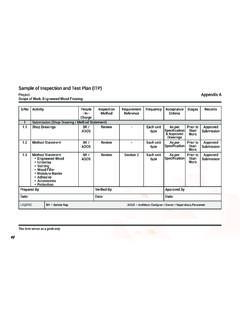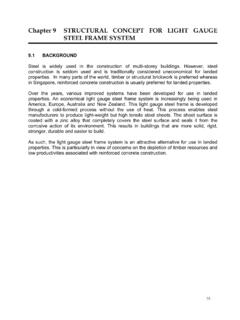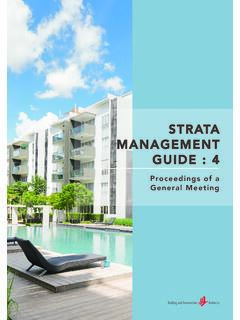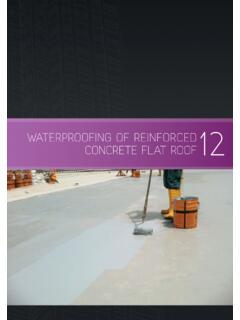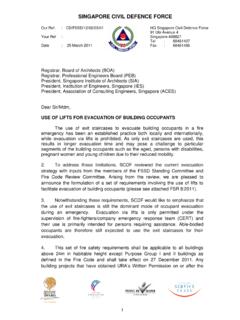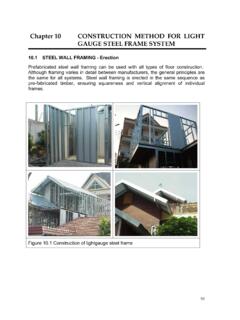Transcription of Singapore - Building and Construction Authority
1 SingaporeLeading the Way for green BuiLdingS in the tropicSCONTENTS5 INTRODUCTION8 TAKING THE FIRST STEP14 THE GREEN Building MASTERPLAN26 GREENING THE VALUE CHAIN: Building EXPERTISE AND ENGAGING STAKEHOLDERS34 THE PATH AHEAD: Singapore , A GLOBAL LEADER IN GREEN BUILDINGS, WITH EXPERTISE IN THE TROPICS AND SUB-TROPICSP rinted on Recycled Paper23 INTrOduCTIONCome 2030, Singapore will be much greener than today when 80 per cent of its buildings is certified green - that is, energy and water efficient, with a high quality and healthy indoor environment, integrated with green spaces and constructed from eco-friendly materials. The energy consumption in buildings can be reduced by 30% to 80% using proven and commercially available : United Nations Environment Programme Report40% of global energy consumption and resources1/ 3 of greenhouse gas emissions25% of global water consumptionBuildings account for:This is the goal set by the Inter-Ministerial Committee on Sustainable Development (IMCSD) which charts Singapore s national sustainability strategies.
2 To achieve this goal, the Building and Construction Authority (BCA) of Singapore has set out specific initiatives to lead Singapore s Building and Construction industry in greening our built Singapore s densely built-up urban environment, with limited land space and few natural resources, greening buildings is vital to sustainability. It is one of the most effective ways for a city to reduce its carbon footprint in the long term, whether in terms of energy and water efficiency, waste reduction or the use of sustainable materials. In 2005, BCA kick -started its drive to green Singapore s physical landscape by launching the BCA Green Mark: a rating system to evaluate a Building s environmental impact and recognise its sustainability performance, designed specifically for buildings in the tropics.
3 Image courtesy of PARKROYAL on Pickering45In 2009, the second Green Building Masterplan was launched to bring existing buildings into the green fold, by having the the public sector take the lead, spurring the private sector through the various incentive schemes and setting minimum legislated standards for existing buildings. The second masterplan also gave more prominence to Research and Development (R&D), and greater emphasis on profiling Singapore as an international leader in green Building , over recent years, the success of BCA s Green Building Masterplan has been recognised not just locally but internationally. Singapore s expertise in green buildings is showcased in high profile multi-national developments such as the Sino- Singapore Tianjin Eco-City; in thought leadership centres such as the BCA Centre for Sustainable Buildings, a collaboration between BCA and the United Nations Environment Programme; and in gatherings such as the International Green Building Conference, hosted here annually.
4 Since its introduction, the Green Mark certification programme has undergone several revisions and has evolved to incorporate increasingly sophisticated methods of greening buildings. The standards it covers today include a greater variety of the Building types and spaces, the higher emphasis on passive design, the use of sustainable Construction materials and development of performance-based design and systems, amongst others. There is also greater focus on the needs and well-being of Building 2006, the BCA introduced the first Green Building Masterplan, which brought together financial incentives, legislation, industry training programmes and a public outreach campaign to place green buildings in the forefront of industry and consumer awareness.
5 The first Masterplan focused on greening new embarked on our green Building journey as a commitment to our environment. In a short span of 8 years, the number of green buildings in Singapore had increased a hundred times from a mere 17 in 2005 to almost 1700 in 2013 through the BCA Green Mark certification programme and other various initiatives. There is also greater awareness of the benefits and strong business case of green buildings. We are encouraged by these positive results and will continue to review our plans in charting Singapore s leadership in green Building advancement in the tropics. Dr John Keung, CEO of BCA Most recently, in June 2013, the BCA became the first government agency outside North America and Europe to receive the Alliance to Save energy s International Star Award.
6 Its commitment and leadership in green Building development was also reflected in other international accolades such as the World Green Building Council s Government Leadership Award and Aspen Institute energy and Environment (Government) , with all key initiatives under the second Green Building Masterplan successfully implemented, BCA is embarking on its third Green Building Masterplan as a further expansion of the previous masterplan. The new vision is to be a global leader in green buildings, with special expertise in the tropics and sub-tropics. The new strategy will guide the Building and Construction industry here in the development of software , to match the hardware put in place earlier.
7 This involves a paradigm shift in the consumption behaviour of Building occupants, the development of industry knowledge, and the Building of green Building expertise which Singapore is ultimately poised to share with the rest of the world. Image courtesy of Kwan Sai Hoe, BCA Green Shots Competition 201367 TAKI NG THE FIrST STEPH ence, in the mid-2000s, the Building and Construction Authority (BCA) began developing its own green Building rating tool designed specifically for tropical and sub-tropical conditions: the Green Mark certification programme. The certification programme was launched in 2005 for voluntary participation, following consultations with industry players, some of whom had already ventured into green introduction of the certification programme was a bold initiative to move Singapore s Building and Construction industry towards environmentally-friendly buildings by providing a standard benchmark and guideline for the industry to follow when constructing new buildings or retrofitting existing buildings.
8 INTERNATIONAL COMPARABILITYThe BCA Green Mark has been described as the tropics answer to the US-developed Leadership in energy and Environmental Design (LEED) certification. It differs from other green Building rating systems in these points: A stronger emphasis on energy efficiency; Tailored to tropical climates: heat gain and cooling of inner spaces with air-conditioning are key design considerations; High standards of measurement and verification instrumentations for air-conditioning chiller plants to ensure continual performance monitoring. Unlike other rating systems administered by non-governmental organisations, BCA works closely with Building owners to conduct regular follow-up sessions and post-occupation verifications.
9 This is to ensure that design features are properly implemented and the Building performs to the standards set under the BCA Green versions of the Green Mark will continue to focus on total Building energy consumption, while placing greater importance on internal environment quality and health, life cycle and environmental impact, and the consumption and behaviour of Building FIRST MOVERSP rior to the Green Mark, a number of players in the local Construction industry had already begun integrating sustainability into their business practices for some time. Sustainable urban planning has always occupied a prominent role in development.
10 However, prior to the 2000s, guidelines for sustainable buildings were scarce in the tropics and sub-tropics, and existing guidelines which originated primarily from the US and Europe did not necessarily apply in Singapore s climate. These included major developers such as CapitaLand Limited, City Developments Limited (CDL), the Housing and Development Board (HDB) and JTC Corporation. Many individual buildings, both new and existing, had also adopted sustainable design elements and operating practices. Not surprisingly, these first movers were also among the first to be recognised by the Green Mark.
